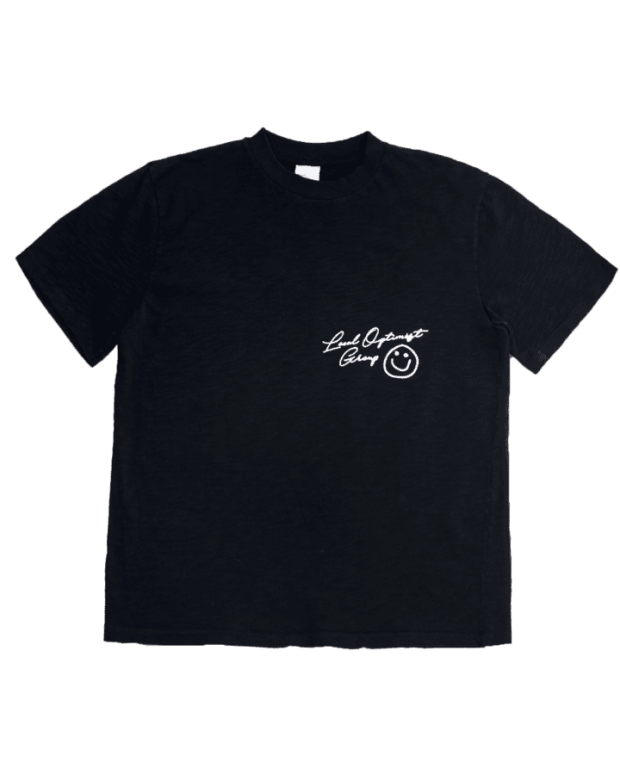How Madhappy Turned T-Shirts Into A Lifestyle Brand

T-shirts and hoodies are not, generally speaking, complex fashion items. The average T-shirt costs about $6 to manufacture (overseas), a high-quality hoodie can run from $11 to $18 to make (also overseas) and T-shirt manufacturers aren’t hard to find. And pretty much everyone wears them regardless of demographic profile. People from the age of 9 days to 90 years wear T-shirts.
As a result T-shirts are sold just about everywhere, at just about every type of apparel retailer and at a stunningly wide array of price points. A shopper can pay $3.42 for a T-shirt at Walmart or $595 for a Dolce Gabbana T-shirt at Neiman Marcus.
The difference between those two products? According to the experts, cut, quality of stitching, quality of materials used, complexity of design, quality of dyes and other factors can all influence the purchase price of a T-shirt. In the above case, however, the largest and most important differentiator between the two shirts is that one has a Dolce Gabbana “Fashion Explosion Patchwork Logo” and the other does not.
When the brand is a well-known luxury provider like Dolce Gabbana, it can charge whatever it wants for a T-shirt, since the customer is arguably not purchasing the shirt so much as the cache of the logo on it. But for a startup, selling an expensive T-shirt can be something of a bigger challenge — because its unknown logo alone does not quite have the ability to tempt a buyer.
Such was the challenge Noah Raf faced when starting up Madhappy — a streetwear brand with a specialty in T-shirts and hoodies that has in the the two years since its founding become known to enthusiasts not as a brand that sells $70 T-shirts and $130 hoodies, but instead as a lifestyle brand that pushes the power of positivity for millennial customers.
The tees and hoodies are all manufactured in Los Angeles. Many of the tees are plain, except for the Madhappy logo on the top left-hand side of the shirt. Other tees feature a graphic of the peace sign. The T-shirts are also reportedly hyper-soft — after going through a high-enzyme wash. The hoodies feature the brand’s unique hand stitching — which according to Madhappy means that no two hoodies are ever exactly alike.
And Raf noted, for the founders, it was important that their brand felt good to wear in ways that went beyond the physical.
“Optimism was really important to us because personally — the founders — we were either dealing with mental health issues or close friends around us were. We thought that we could tap into the market while being unique — especially because we were coming into the market at a streetwear angle. Every streetwear brand we were seeing had this dark persona, and we wanted to turn that on its head,” Raf said.
Positivity alone, however, is not quite enough to launch a brand, but Raf and company came up with a novel way to launch their shirts: parties. According to Raf, the Madhappy label hosted free parties for hundreds of people in a 12-month period after its initial launch. From LA To Williamsburg (with a few hip spots like Aspen in between) Madhappy hosted pop-up shops that were home to pop-up parties complete with a DJ and open bar for patrons.
Displays of Madhappy tees and hoodies were there, but not the center of the events — and in fact key to Madhappy’s early strategy was to focus on the party “being awesome” rather than on selling clothes at the events.
“We wanted to create a community. We wanted to build a community-driven lifestyle that promotes mental health, optimism and inclusion.”
Building that community paid off, as the party attendees did in fact do what Raf and his co-founders hoped they would — went home, slept it off (or not) and then went off to Madhappy’s direct-to-consumer site where they would purchase those pricier than average T-shirts and sweatshirts.
And, as Raf notes, Madhappy’s contributions as a lifestyle brand work because of the brand’s total commitment to its mission as an optimism messenger brand — having even partnered up with three charities for an ongoing charity program: DonorsChoose, the American Foundation for Suicide Prevention and the National Alliance to End Homelessness. Last fall, to promote its partner charities, Madhappy says it donated $1 for every re-shared post.
Today Madhappy fashions can only be purchased directly from Madhappy’s website — though the brand’s vision for the future involves a stretch into wholesale at some point. And of course, the party-down pop-ups will carry on — though they will be supplemented with perhaps less expected things like panels and speakers on mental health.
Because as Raf notes, at the end of the day, Madhappy doesn’t just want to sell clothes — but clothes that elevate their wearer’s experience of life. And judging by the increasingly large collection of breathlessly enthusiastic reviews the brand has drawn, it may well succeed.
